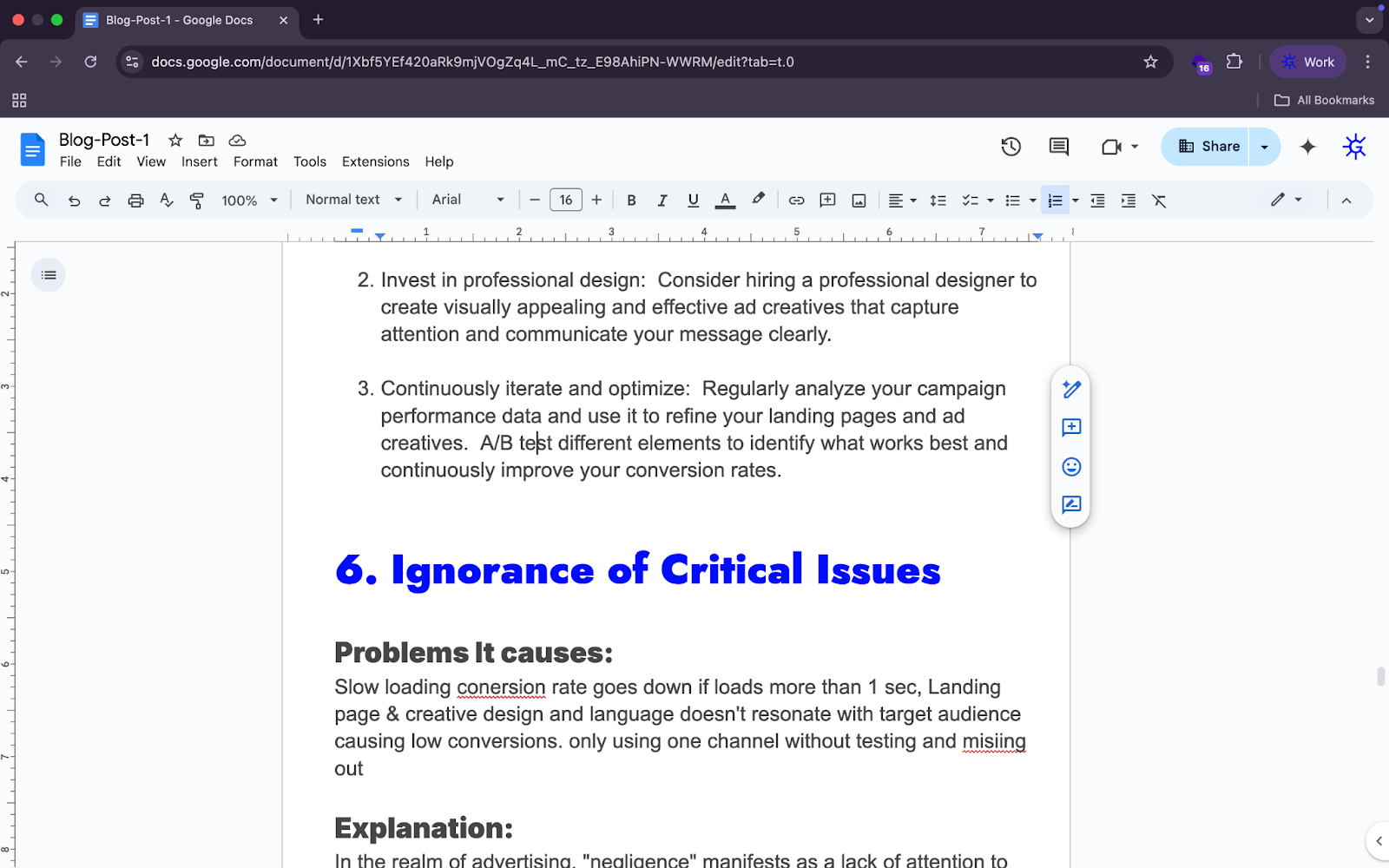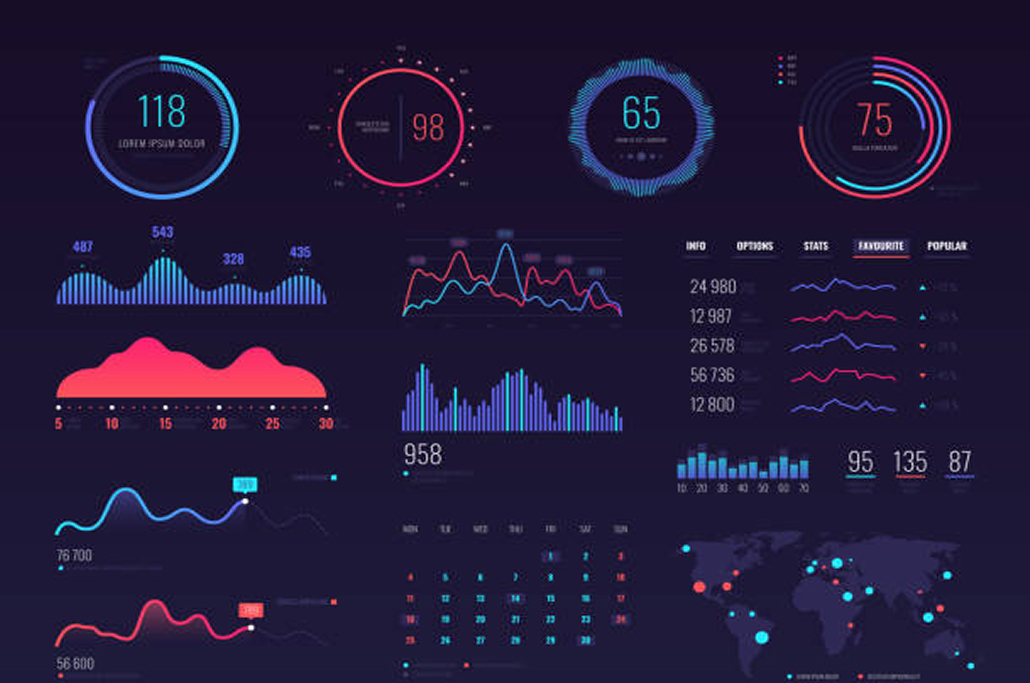data blah blah

Imagine the revenue you're losing every day because your ads aren't converting. It's like pouring water into a leaky bucket – no matter how much you pour, you'll never fill it up. But here's the good news: it's not about spending more on ads; it's about making your existing ads work harder. Throughout this post, we'll show you how to plug the leaks in your campaigns, optimize your strategy, and unlock their full potential to drive real results from your ad spend.
Let’s dive into the 7 deadly sins by explaining each using a real life example and then giving you actionables to solve those problems.Okay, so let's talk about the seven deadly sins, shall we? We'll break each one down with a real-life example and then give you some practical tips on how to deal with them.
1. The Lust for fast results
Problems It causes:
- No understanding of target audience
- Ad budgeting
- Insufficient Testing
- Low conversions
- High CPC
Explanation:
"Lust," in the context of advertising, refers to an overwhelming desire for immediate results. This impatience can lead marketers to skip crucial steps like thorough audience research, careful budget allocation, and rigorous A/B testing. They crave instant gratification – seeing those clicks and conversions roll in right away – and this urgency can blind them to the long-term strategies that truly optimize ad campaigns.
Real Life Example:
Meet Alex, the ambitious entrepreneur launching a new line of eco-friendly cleaning products. He's eager to make a splash in the market and decides to dive headfirst into a Google Ads campaign. Without pausing to define his ideal customer profile, he targets keywords like "cleaning supplies" and "household products," casting a wide net in hopes of reaching everyone. He sets a hefty daily budget, assuming more spend equals more leads. He creates a single ad variation and links it directly to his homepage, skipping A/B testing altogether.
Initially, Alex is thrilled. Clicks are pouring in, and he feels like he's on the fast track to success. But as the weeks go by, a troubling pattern emerges. While clicks are high, conversions are dismally low. He's spending a fortune on clicks from people who aren't interested in his specific niche of eco-conscious cleaning products. His generic ad copy and landing page fail to resonate with his target audience, and the lack of testing means he has no data to identify areas for improvement.
Alex's "lust" for quick results has led him down a costly path. His impatience has resulted in poor targeting, overspending, and insufficient testing, ultimately driving up his cost-per-click (CPC) and hindering his conversion rates.
Solution:
To combat the "lust" for quick wins, adopt a more patient and strategic approach:
- Invest time in thorough audience research: Define your ideal customer profile, including their demographics, interests, pain points, and online behavior.
- Allocate your budget wisely: Start with a modest budget and gradually increase it as you gather data and optimize your campaigns. Explore different bidding strategies to maximize your ROI.
- Embrace A/B testing: Experiment with different ad elements (headlines, visuals, calls to action) and landing page variations to identify what resonates best with your audience.
2. Gluttony for Clicks
Problems It causes:
- Irrelevant audience: Low conversion rates due to a large portion of ads reaching an irrelevant audience.
- Inflated expenses: Bots increase advertising costs and distort data.
- Wasted ad impressions: Broad target audience leads to ad impressions and clicks from uninterested users.
Explanation:
In the realm of advertising, "gluttony" manifests as an insatiable hunger for impressions and clicks, leading to excessive spending without a focus on quality or relevance. Marketers falling prey to this sin cast their nets too wide, targeting overly broad audiences in the hopes of reaching everyone. This approach, however, often results in attracting a significant portion of unqualified traffic – users who are unlikely to convert and may even be bots.
Real Life Example:
Imagine Melissa, a passionate baker who recently launched her online cookie delivery business. Eager to spread the word (and the deliciousness), she sets up a Facebook ad campaign with a massive target audience: anyone in the country who likes "desserts." She pumps a significant portion of her budget into this campaign, believing that reaching the maximum number of people will translate into maximum sales.
While the campaign generates a high volume of clicks, Melissa soon notices a disheartening trend. The majority of this traffic bounces quickly, with users spending mere seconds on her website before leaving. Conversion rates are abysmal, and her sales figures are nowhere near her expectations. Upon closer inspection, she discovers a significant portion of the traffic originates from suspicious IP addresses, indicating bot activity.
Melissa's "gluttonous" approach to advertising has backfired. Her overly broad targeting attracted a large but irrelevant audience, including bots that artificially inflated her click count. This resulted in wasted ad spend, a low conversion rate, and a disappointing return on her investment.
Solution:
To overcome the "gluttony" of overspending and irrelevant traffic, adopt a more discerning and strategic approach:
- Refine your targeting: Instead of casting a wide net, focus on your ideal customer profile. Utilize detailed targeting options (demographics, interests, behaviors) to reach the specific audience most likely to be interested in your product or service.
- Prioritize quality over quantity: Focus on attracting qualified traffic that is more likely to convert, even if it means reaching a smaller audience.
- Implement bot detection and filtering: Use tools and techniques to identify and filter out bot traffic, ensuring your data accurately reflects human engagement.
- Monitor your campaign performance closely: Track key metrics like conversion rates, bounce rates, and cost-per-conversion to identify areas for improvement and ensure your budget is being utilized effectively.
By focusing on quality over quantity and implementing measures to filter out irrelevant traffic, you can avoid the pitfalls of "gluttony" and optimize your ad campaigns for genuine engagement and conversions.
3. Greed for Profit
Problems It causes:
Overcharging relative to competition, hidden charges, and fake promises leading to a negative customer experience and hindering conversions.
Explanation:
In the context of advertising, "greed" manifests as a relentless pursuit of profit at the expense of customer satisfaction. Marketers driven by this sin prioritize short-term gains over building long-term relationships with their audience. This can lead to deceptive advertising practices, inflated prices, hidden fees, and exaggerated promises that ultimately erode trust and damage brand reputation.
Real Life Example:
Meet George, the owner of a struggling online clothing store. Desperate to boost sales, he decides to run a flashy ad campaign on social media. He crafts attention-grabbing ads showcasing his latest collection, but with a catch: the prices displayed are significantly higher than those of his competitors. He justifies this by claiming his clothing is "exclusive" and "superior quality," even though it's sourced from the same manufacturers as his rivals.
To further entice customers, George includes a "free shipping" offer in his ads, but hides a hefty "handling fee" at the checkout page. He also uses retouched images that make the clothing appear more vibrant and flattering than it is in reality.
Initially, George sees a surge in traffic and orders. But this success is short-lived. Customers who receive their orders are disappointed by the inflated prices and hidden fees. They feel misled by the exaggerated claims and retouched images. Negative reviews start pouring in, and word-of-mouth spreads about George's deceptive practices.
George's "greed" has backfired. His focus on maximizing profit in the short term has alienated customers, damaged his brand reputation, and ultimately hindered his long-term success.
Solution:
To overcome the "greed" that can sabotage your advertising efforts, prioritize customer satisfaction and build trust through transparent and ethical practices:
- Offer competitive pricing: Research your competitors and ensure your pricing is fair and reflects the value you provide. Avoid artificially inflating prices to maximize profits.
- Be upfront about all costs: Clearly disclose any additional fees or charges upfront in your ads and on your website. Avoid surprising customers with hidden costs at the checkout.
- Deliver on your promises: Ensure your ads accurately reflect the quality and features of your products or services. Avoid exaggerating claims or using misleading visuals.
- Focus on building relationships: View your customers as long-term partners, not just transactions. Provide excellent customer service, respond to feedback, and nurture relationships to foster loyalty and advocacy.
By prioritizing customer satisfaction and building trust through transparent and ethical advertising practices, you can avoid the pitfalls of "greed" and create sustainable, long-term success.
4. Pride over experience
Problems It causes:
being left behind because of the changing market, wrong audience targeting, lost opportunity
Explanation:
In the ever-evolving world of advertising, "pride" can be a significant roadblock to success. It manifests as an overreliance on intuition and assumptions, blinding marketers to the valuable insights hidden within data. Those who succumb to this sin often dismiss analytics, ignore A/B testing results, and fail to adapt their strategies based on real-world feedback. This arrogance can lead to stagnant campaigns, missed opportunities, and ultimately, being left behind in a dynamic market.
Real Life Example:
Meet David, a seasoned marketing director with years of experience under his belt. He's confident in his instincts and believes his gut feeling is always right. When launching a new campaign for a revolutionary tech gadget, he relies on his past successes and dismisses the need for in-depth audience research. "I know what people want," he declares, brushing aside suggestions to conduct surveys or analyze user data.
He crafts compelling ad copy and selects eye-catching visuals, but his targeting remains broad, assuming the product will appeal to a wide demographic. He launches the campaign with a sense of unwavering confidence.
However, the results are disappointing. Click-through rates are low, and conversions are even lower. His team suggests A/B testing different headlines and calls to action, but David remains unconvinced. "My ad copy is perfect," he insists, "the problem must be with the product itself."
David's "pride" prevents him from acknowledging that his assumptions might be wrong. He's ignoring valuable data that could reveal critical insights about his target audience and their preferences. He fails to adapt his campaign, missing the opportunity to optimize its performance and reach its full potential. As the market shifts and competitors refine their strategies based on data-driven insights, David's campaign stagnates, and his company loses ground.
Solution:
To overcome the "pride" that can hinder your advertising success, embrace a data-driven approach and cultivate a willingness to learn and adapt:
- Value data over assumptions: Base your decisions on concrete data and analytics rather than relying solely on intuition or past experiences.
- Embrace A/B testing: Continuously test different ad elements (headlines, visuals, calls to action) and landing page variations to identify what resonates best with your target audience.
- Analyze user behavior: Track key metrics like click-through rates, conversion rates, and bounce rates to understand how users interact with your ads and website.
- Stay informed about market trends: Keep abreast of the latest industry trends, technologies, and best practices to ensure your strategies remain relevant and effective.
- Be open to feedback: Encourage feedback from your team, customers, and analytics to identify areas for improvement and optimize your campaigns.
By adopting a humble and data-driven approach, you can avoid the pitfalls of "pride" and ensure your advertising strategies remain agile, effective, and aligned with the ever-changing market.
5. Negligence of Quality
Problems It causes:
Irrelevant/unoptimized Landing Page that don't align to the ad, Low-Quality & no iteration for Creatives leading to low clicks
Explanation:
In the realm of advertising, "negligence" manifests as a lack of attention to detail and a disregard for optimization. Marketers who fall prey to this sin often overlook crucial elements of their campaigns, leading to a disjointed and ineffective user experience. This can include creating generic landing pages that fail to align with the ad's message, using low-quality or irrelevant ad creatives, and neglecting to iterate and improve their campaigns based on performance data.
Real Life Example:
Meet Emily, a busy entrepreneur juggling multiple responsibilities. She decides to run an ad campaign to promote her new online course on productivity. However, pressed for time, she hastily throws together a landing page using a generic template. The page lacks a clear value proposition, the design is cluttered, and the call to action is weak. She also uses a stock photo for her ad creative that has little relevance to her course topic.
Emily launches the campaign and waits for the enrollments to roll in. But to her dismay, conversions are dismal. People who click on her ad are greeted with a confusing landing page that doesn't resonate with the ad's promise. The low-quality creative fails to capture attention and convey the value of her course. Emily's "negligence" in crafting these crucial elements has resulted in a disjointed user experience and a low conversion rate.
Solution:
Overcoming "negligence" requires a commitment to quality, attention to detail, and a willingness to invest in professional expertise:
- Craft high-converting landing pages: Ensure your landing pages are specifically designed to align with your ad's message and guide users towards conversion. This includes:
* A clear and compelling headline that reinforces the ad's promise.
* A concise and persuasive explanation of your offer's value proposition.
* High-quality visuals that are relevant to your product or service.
* A strong call to action that encourages users to take the next step.
* A user-friendly design that is easy to navigate and mobile-optimized. - Invest in professional design: Consider hiring a professional designer to create visually appealing and effective ad creatives that capture attention and communicate your message clearly.
- Continuously iterate and optimize: Regularly analyze your campaign performance data and use it to refine your landing pages and ad creatives. A/B test different elements to identify what works best and continuously improve your conversion rates.

6. Ignorance of Critical Issues
Problems It causes:
Slow loading conersion rate goes down if loads more than 1 sec, Landing page & creative design and language doesn't resonate with target audience causing low conversions. only using one channel without testing and misiing out
Explanation:
In the realm of advertising, "negligence" manifests as a lack of attention to detail and a disregard for optimization. Marketers who fall prey to this sin often overlook crucial elements of their campaigns, leading to a disjointed and ineffective user experience. This can include creating generic landing pages that fail to align with the ad's message, using low-quality or irrelevant ad creatives, and neglecting to iterate and improve their campaigns based on performance data.
Real Life Example:
Meet Michael, a talented chef who recently opened a new restaurant. Excited to attract customers, he decides to run an online ad campaign. However, Michael isn't tech-savvy and isn't aware of the importance of website optimization. His landing page, though beautifully designed, is laden with high-resolution images and complex animations that cause it to load incredibly slowly.
Furthermore, the language he uses in his ad copy and landing page is filled with culinary jargon that the average person might not understand. He focuses solely on Facebook ads, neglecting other potentially valuable channels like Google Ads or Instagram.
While Michael's ads generate clicks, potential customers quickly become frustrated with the slow loading times and confusing language. They bounce off the page before even seeing his menu or making a reservation. His lack of awareness regarding website optimization, target audience communication, and channel diversification is costing him valuable conversions.
Solution:
- Optimize website speed: Ensure your landing pages load quickly (ideally within 1-2 seconds) by optimizing image sizes, leveraging browser caching, and using a content delivery network (CDN).
- Know your audience: Conduct thorough audience research to understand their demographics, interests, and online behavior. Use language and visuals that resonate with them and address their specific needs and pain points.
- Diversify your channels: Explore different marketing channels (Google Ads, social media platforms, email marketing) to reach a wider audience and reduce reliance on a single platform.
- Stay updated on best practices: Continuously educate yourself about the latest design principles, advertising trends, and technological advancements to ensure your campaigns remain effective.
- Consider professional support: Don't hesitate to seek professional help from web developers, designers, and marketing experts who can provide valuable insights and guidance.
7. Procrastination of optimization
Problems It causes:
Lost opportunity, Wasted budget due to putting off testing and optimization
Explanation:
In the dynamic landscape of online advertising, "procrastination" can be a costly mistake. This sin manifests as a tendency to delay crucial tasks, such as A/B testing, campaign optimization, and data analysis. Marketers who fall prey to procrastination often put off these essential activities, citing lack of time or a belief that things will "work themselves out eventually." However, this inaction can lead to missed opportunities, wasted ad spend, and a failure to capitalize on valuable insights that could significantly improve campaign performance.
Real Life Example:
Meet Ethan, a marketing manager for a SaaS company offering a project management tool. He launches a Google Ads campaign targeting businesses in the tech industry. Despite a promising start, Ethan gets distracted by other projects and neglects to monitor the campaign's performance.
Weeks go by, and Ethan finally takes a look at the data. He discovers that while the campaign is generating clicks, conversions are low. A closer analysis reveals that the landing page is too generic, failing to highlight the unique benefits of the software. Additionally, the call to action is weak, and the pricing information is buried deep within the page.
Ethan's procrastination has cost his company valuable leads and potential revenue. Had he monitored the campaign more closely and made necessary adjustments, he could have identified these issues early on and optimized the landing page for better conversions. By delaying action, Ethan has missed out on the opportunity to maximize the campaign's ROI.
Solution:
To overcome the "procrastination" that can sabotage your advertising efforts, cultivate a proactive mindset and prioritize timely action:
- Streamline your workflow and maximize efficiency:
* Prioritize tasks strategically: Identify the most critical tasks that directly impact your campaign's performance and prioritize them accordingly.
* Leverage automation tools: Utilize automation software to streamline repetitive tasks and free up time for more strategic activities.
* Break down large tasks into smaller, actionable steps: This can make them seem less daunting and increase your motivation to complete them.
* Foster a culture of accountability and continuous improvement:
- Set clear goals and deadlines: Establish specific, measurable, achievable, relevant, and time-bound (SMART) goals for your campaigns. This will create a sense of urgency and accountability.
- Track your progress and celebrate milestones: Regularly review your progress and celebrate achievements to stay motivated and focused.
- Encourage a growth mindset: Embrace a mindset of continuous learning and improvement, recognizing that setbacks are opportunities for growth.
- Seek professional support when needed:
* Consider outsourcing non-core tasks: If you're overwhelmed with day-to-day activities, consider delegating non-core tasks to a virtual assistant or freelancer. This can free up your time to focus on strategic initiatives and high-priority tasks. - Consult with experts for guidance: Seek advice from marketing professionals who can provide valuable insights, recommendations, and support. This can be particularly helpful when you're facing complex challenges or need specialized expertise.
By overcoming "procrastination" and investing in professional support, you can ensure your ad campaigns are continuously optimized for maximum performance and ROI.

- Set clear goals and deadlines: Establish specific, measurable, achievable, relevant, and time-bound (SMART) goals for your campaigns. This will create a sense of urgency and accountability.
- Track your progress and celebrate milestones: Regularly review your progress and celebrate achievements to stay motivated and focused.
- Encourage a growth mindset: Embrace a mindset of continuous learning and improvement, recognizing that setbacks are opportunities for growth.
- Seek professional support when needed:
* Consider outsourcing non-core tasks: If you're overwhelmed with day-to-day activities, consider delegating non-core tasks to a virtual assistant or freelancer. This can free up your time to focus on strategic initiatives and high-priority tasks. - Consult with experts for guidance: Seek advice from marketing professionals who can provide valuable insights, recommendations, and support. This can be particularly helpful when you're facing complex challenges or need specialized expertise.




.png)
.png)
